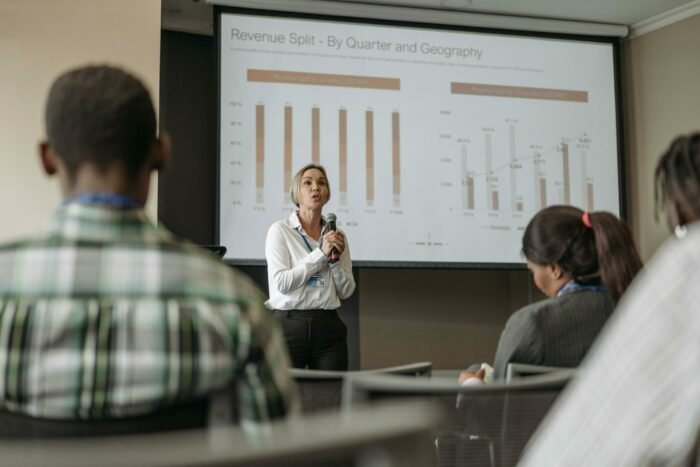As professionals, we constantly strive to excel in our careers and make a lasting impact in the workplace. We work hard, acquire knowledge, and develop our skills, all in the pursuit of success. But there’s often a missing link between our hard work and the level of success we achieve. That missing link is leadership presence.
Leadership presence is what sets individuals apart and propels them forward in their careers. It is the ability to inspire confidence in others, to lead and influence effectively, and to make a powerful impression. Elevating your leadership presence can be the key to unlocking new opportunities and reaching new heights.
But what exactly is leadership presence? It’s a multifaceted quality that combines characteristics, behaviors, and communication skills that exude confidence, authority, and gravitas. It’s the first factor that people consider when meeting a leader and plays a crucial role in inspiring trust and respect.
So, how can you improve your executive presence? It’s not something that happens overnight, but with the right focus and effort, you can enhance your leadership presence and have a significant impact in your professional life.
Key Takeaways
- Elevating leadership presence is crucial for career advancement and success.
- Executive presence is the ability to inspire confidence and effectively lead and influence others.
- Focusing on areas such as self-confidence, communication, gravitas, and presence can enhance leadership presence.
- Improving self-confidence involves setting achievable goals, seeking feedback, and investing in self-care.
- Effective communication is essential for executive presence, including tailoring messages to different audiences.
Developing gravitas and staying present in interactions are also important components of executive presence. By honing these skills and qualities, you can elevate your leadership presence and become a powerful force in your professional life.
What is Executive Presence?
Executive presence is a quality that sets leaders apart from their colleagues. It encompasses a combination of characteristics, behaviors, and communication skills that exude confidence, authority, and gravitas. When meeting a leader, executive presence is the first factor that people consider. It plays a crucial role in inspiring trust and respect, establishing a strong foundation for effective leadership.
To understand executive presence, it is important to recognize its key components. These include:
- Confidence: Executives with presence have a strong belief in themselves and their abilities. They project self-assuredness in their actions and decisions, instilling confidence in those around them.
- Authority: Leaders with executive presence command authority through their knowledge, expertise, and experience. They have a deep understanding of their domain and can effectively guide others.
- Gravitas: Executives possessing gravitas have a certain presence and seriousness that commands attention and respect. They possess an aura of wisdom, poise, and composure.
- Communication skills: Clear and impactful communication is an essential aspect of executive presence. Effective leaders are able to convey their ideas with clarity, engage their audience, and adapt their style to different situations.
By comprehending the essence of executive presence and its defining elements, individuals can work towards improving their own presence and enhancing their leadership skills. Developing executive presence requires self-awareness, practice, and continuous learning, but the rewards are immense.
Take a moment to reflect on the presence you exude as a leader. Consider how you can further develop your confidence, authority, gravitas, and communication skills. By doing so, you can elevate your executive presence and make a lasting impact in your professional endeavors.
How to Improve Your Executive Presence
Improving executive presence is a journey that requires dedication and effort. By focusing on key areas such as self-confidence, communication, gravitas, and presence, you can enhance your executive presence and make a lasting impact as a leader.
Developing Self-Confidence
Self-confidence is a fundamental building block of executive presence. To boost your self-confidence, start by setting achievable goals and celebrating small wins along the way. Seek feedback from trusted mentors or colleagues to gain valuable insights and identify areas for improvement. Additionally, prioritize self-care to maintain a positive mindset and enhance your overall well-being.
Enhancing Communication Skills
Effective communication is essential in building executive presence. Tailor your messages to different audiences, ensuring clarity and conciseness. Use active listening techniques to demonstrate interest and empathy. Remember, communication is not just about speaking but also about listening and understanding the perspectives of others.
Cultivating Gravitas
Gravitas is the ability to remain calm, composed, and authoritative in high-pressure situations. Develop your ability to think strategically, make sound decisions, and stay focused in challenging circumstances. Engage in continuous learning to expand your knowledge and expertise, which will help you exude confidence and inspire respect.
Mastering Presence and Non-Verbal Communication
Presence goes beyond just being physically present. It involves fully engaging in interactions and being aware of non-verbal cues. Pay attention to your body language, maintaining an open and confident posture. Make eye contact to establish connection and demonstrate attentiveness. These non-verbal cues contribute significantly to your executive presence.
By focusing on these key areas and investing in your personal and professional development, you can continuously improve your executive presence. Remember, enhancing your leadership skills is an ongoing process that requires practice and perseverance. With time and dedication, your improved executive presence will contribute to your success as a leader.
The Importance of Confidence in Executive Presence
Self-confidence is the cornerstone of executive presence. As a leader, I understand that believing in oneself is vital before expecting others to believe in me. Building self-confidence involves a deep understanding of our strengths and weaknesses. By acknowledging our areas for improvement, we can set realistic goals and pursue opportunities for growth.
Seeking feedback is an essential part of building self-confidence. It allows us to gain valuable insights from others, identify blind spots, and refine our skills. Constructive criticism helps us focus on areas that need improvement, enabling us to become better leaders.
“Seeking feedback is not a sign of weakness, but a testament to our commitment to personal and professional growth.” – John Maxwell
Another vital aspect of building self-confidence is taking care of ourselves. This includes maintaining a healthy work-life balance, prioritizing self-care, and cultivating a positive mindset. When we feel our best physically, emotionally, and mentally, we exude confidence and project it onto others.
The Role of Leadership Presence Coaching
Leadership presence coaching can be immensely valuable in developing self-confidence. Working with experienced coaches who specialize in leadership development allows us to gain insights into our strengths and areas for improvement. These coaches provide personalized guidance, helping us navigate challenges and grow into more confident leaders.
Through leadership presence coaching, we can learn techniques and strategies to enhance our overall presence and influence. Coaches provide us with valuable feedback, offer support and accountability, and guide us on our leadership journey.
Enhancing Leadership Communication Skills
Effective communication is a crucial component of executive presence. By honing our leadership communication skills, we can confidently articulate our ideas and opinions to inspire and influence others. Clear and concise communication ensures our messages are understood and leaves a lasting impact.
“Effective communication is one of the primary predictors of success in leadership.” – John C. Maxwell
Leadership presence coaching also assists in refining communication skills. Coaches can provide tailored guidance on public speaking, presenting with impact, active listening, and adapting communication styles for different audiences. These skills enable leaders to engage and connect with others, driving meaningful conversations and building trust.
The Role of Communication in Executive Presence
Effective communication plays a vital role in cultivating executive presence. As leaders, our ability to articulate our ideas and connect with others is instrumental in establishing a strong presence in the workplace. Employing assertive communication techniques empowers us to convey our thoughts and opinions with clarity, conviction, and confidence.
When practicing assertive communication, it is important to tailor our messages to suit the needs and preferences of our diverse audience. By understanding their backgrounds, interests, and priorities, we can craft impactful leadership presentations that resonate with them on a deeper level. This tailored approach demonstrates our attentiveness and fosters a sense of trust and connection.
I believe that effective communication is not just about the words we choose but also about our ability to project confidence and assertiveness. It is the art of conveying our ideas in a manner that captures attention, commands respect, and invites collaboration.
Executive presence training programs offer valuable guidance and practical techniques for improving our communication skills. These programs provide insights into various communication styles, help us identify our strengths and areas for development, and equip us with strategies to engage and influence others effectively.
Furthermore, impactful leadership presentations are a cornerstone of executive presence. They allow us to showcase our expertise, inspire others with our vision, and leave a lasting impression. By honing our presentation skills, we can captivate our audience, maintain their engagement, and inspire them to take action.
Investing in executive presence training and continuously refining our communication skills empowers us to make a greater impact as leaders. It allows us to express ourselves assertively, connect authentically with others, and establish ourselves as confident and influential professionals.
Developing Effective Communication Skills for Executive Presence
To enhance our communication skills and strengthen our executive presence, consider incorporating the following practices:
- Active Listening: Listening attentively to others demonstrates respect and fosters effective communication.
- Clarity and Conciseness: Conveying our ideas in a clear and concise manner ensures that our message is understood and remembered.
- Body Language: Paying attention to our non-verbal cues, such as maintaining eye contact, using open and confident postures, and employing appropriate gestures, enhances the impact of our communication.
- Empathy: Understanding and considering the perspectives of others allows us to communicate in a way that resonates with them.
- Adaptability: Adjusting our communication style to different situations and audiences enables us to connect and engage more effectively.
Key Elements of Effective Communication for Executive Presence
| Aspect | Description |
|---|---|
| Clear and Concise Messaging | Expressing ideas succinctly and directly, avoiding vague or ambiguous language. |
| Active Listening | Attentively listening to others, demonstrating understanding and empathy. |
| Tailoring Communication | Adjusting communication style based on the needs and preferences of the audience. |
| Body Language | Using confident postures, maintaining eye contact, and employing appropriate gestures to enhance communication. |
| Empathy | Understanding and considering the perspectives and feelings of others during communication. |
| Adaptability | Flexibly adjusting communication style to different situations and audiences. |
Developing Gravitas for Executive Presence
Gravitas is an essential and influential element of executive presence. It encompasses the ability to lead and influence others through one’s presence and demeanor. Leaders with gravitas possess a unique aura that commands respect and authority, making a lasting impression on those around them.
To develop gravitas, individuals must cultivate several key skills. First and foremost, active listening is crucial. By truly hearing and understanding others, leaders can demonstrate empathy and gain valuable insights.
Engaging in strategic thinking is another vital aspect of developing gravitas. Leaders with gravitas possess a clear vision and can make well-informed decisions that drive meaningful outcomes. They are able to navigate complex challenges and present innovative solutions.
Furthermore, effective decision-making skills are essential for leaders looking to develop gravitas. Making sound and confident choices based on thorough analysis and consideration establishes credibility and fosters trust from others.
“Gravitas is not about dominating a room; it’s about inspiring others through a combination of presence, thoughtfulness, and conscientious decision-making.” – Michelle Obama
Building authority and charisma are also critical components of gravitas. By projecting an aura of confidence and authenticity, leaders can establish themselves as trusted figures within their organizations.
Benefits of Developing Gravitas
- Enhanced leadership influence development
- Increased credibility and respect from peers and subordinates
- Improved decision-making abilities
- Greater charisma and presence
Developing gravitas allows individuals to step into their leadership roles with confidence and impact. It enables them to lead with authority and inspire others to achieve their full potential.
Key Strategies for Developing Gravitas
| Strategies | Description |
|---|---|
| Practice active listening | Engage in active listening to understand others and foster meaningful connections. |
| Engage in strategic thinking | Develop a clear vision and make informed decisions that drive successful outcomes. |
| Improve decision-making skills | Make confident choices based on thorough analysis and consideration. |
| Build authority and charisma | Project confidence, authenticity, and a commanding presence. |
By focusing on these strategies, individuals can cultivate an influential presence that sets them apart as leaders. Gravitas allows them to navigate challenges, inspire others, and leave a lasting legacy of impact and success.
The Power of Presence in Executive Presence
Presence plays a vital role in leadership presence enhancement. When we are mentally and physically present in interactions, we create a strong foundation for effective communication and building connections. It’s about being fully engaged and attentive in the present moment.
Non-verbal cues, such as confident leadership body language, can greatly contribute to our presence. Body language, eye contact, posture, and gestures all convey authority and confidence. By refining our body language, we can communicate our leadership presence with impact.
“Body language is a powerful form of communication. With the right posture and gestures, we can project confidence and inspire trust in others.”
To enhance our leadership presence, it is important to stay present and pay attention to these cues. This allows us to not only convey confidence but also to connect on a deeper level with our team members and colleagues. By being fully present, we demonstrate that we value their contributions and ideas.
The image below illustrates the significance of presence in executive presence:
Conclusion
Developing a strong leadership presence is a continuous journey that requires dedication and focus. By prioritizing areas such as self-confidence, communication, gravitas, and presence, individuals can build their leadership credibility, increase their influence, and develop a strong presence. Leadership credibility building starts with cultivating self-confidence. Believing in oneself and knowing one’s strengths and weaknesses lays the foundation for inspiring confidence in others. By setting achievable goals, seeking feedback, and investing in self-care, leaders can enhance their self-confidence and establish their credibility. Effective communication is another key aspect of building leadership influence. Tailoring messages to different audiences, being clear and concise, and projecting confidence and assertiveness are essential to capturing attention and winning the respect of others. By continuously improving communication skills, leaders can enhance their influence and make a lasting impact.
Gravitas and presence are also critical elements of a strong leadership presence. Remaining calm under pressure, engaging in strategic thinking, practicing active listening, and paying attention to non-verbal cues allow leaders to exude authority and charisma. Developing these qualities strengthens leadership influence, making leaders more impactful and inspiring.
In conclusion, by focusing on building leadership credibility, increasing leadership influence, and developing a strong presence, individuals can take their leadership skills to new heights. Through continuous learning, practice, and self-reflection, leaders can elevate their careers and make a significant impact in their professional lives.
FAQ
What is the importance of elevating leadership presence?
Elevating leadership presence is crucial for professionals looking to advance in their careers. It is often seen as the missing link between merit and success. By enhancing leadership presence, individuals can make a lasting impact in the workplace and inspire trust and respect from others.
What is executive presence and why is it important?
Executive presence is the ability to inspire confidence in others and to effectively lead and influence. It combines characteristics, behaviors, and communication skills that exude confidence, authority, and gravitas. Executive presence is the first factor that people consider when meeting a leader, and it plays a crucial role in building trust and respect.
How can I improve my executive presence?
Improving executive presence requires focusing on areas such as self-confidence, communication, gravitas, and presence. Developing self-confidence involves setting achievable goals, seeking feedback, and investing in self-care. Communication skills can be enhanced by tailoring messages to different audiences and being clear and concise. Developing gravitas involves remaining calm and composed under pressure and engaging in strategic thinking. Staying present in interactions and paying attention to non-verbal cues can also enhance executive presence.
What is the role of self-confidence in executive presence?
Self-confidence is the foundation of executive presence. Building self-confidence involves knowing one’s strengths and weaknesses, setting goals, seeking feedback, and taking care of oneself. By developing self-confidence, individuals can enhance their leadership presence and effectively communicate their ideas and opinions.
How does communication impact executive presence?
Effective communication is essential for executive presence. Leaders with executive presence are able to convey their ideas in a clear and concise manner, tailoring their messages to different audiences. By improving communication skills, individuals can enhance their executive presence and make a greater impact as leaders.
What is gravitas and how does it contribute to executive presence?
Gravitas is an important component of executive presence. It involves leading and influencing others through one’s presence and demeanor. Leaders with gravitas remain calm and composed under pressure, exuding a sense of authority and making a lasting impression. Developing gravitas requires practicing active listening, engaging in strategic thinking, and improving decision-making skills.
How does presence play a role in executive presence?
Presence plays a vital role in executive presence. Being mentally and physically present in interactions is essential for effective communication and building connections. Non-verbal cues, such as body language, eye contact, posture, and gestures, can convey authority and confidence. By staying present and paying attention to these cues, individuals can enhance their leadership presence and make a powerful impact as leaders.
Why is developing a strong presence important for leadership?
Developing a strong presence is crucial for leadership. It enhances leadership credibility, increases leadership influence, and helps individuals build their personal leadership brand. By developing a strong presence, leaders can elevate their careers and make a significant impact in their professional lives.









